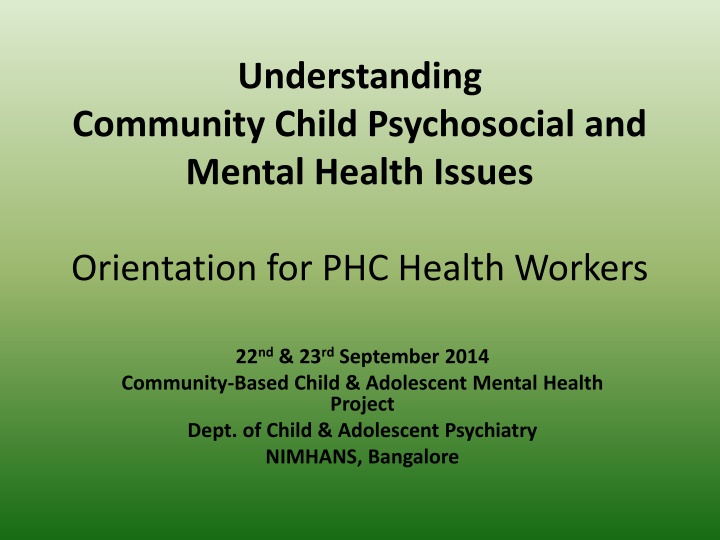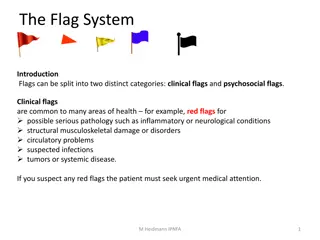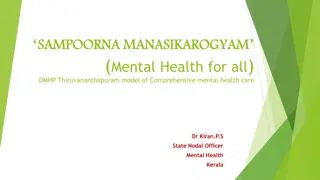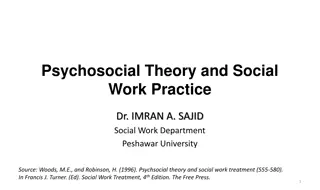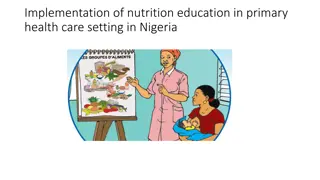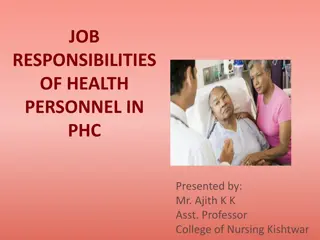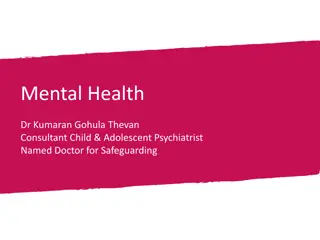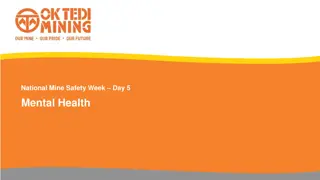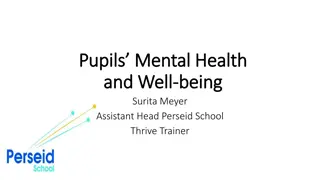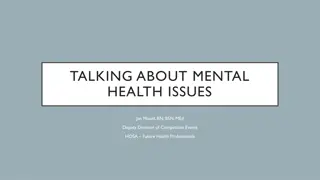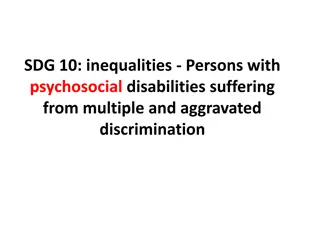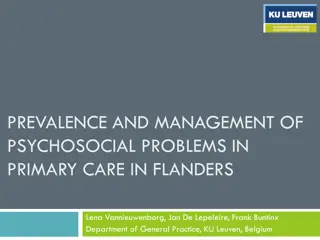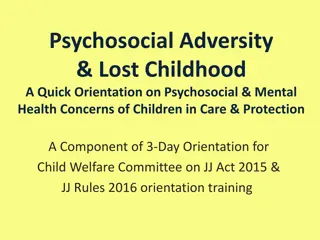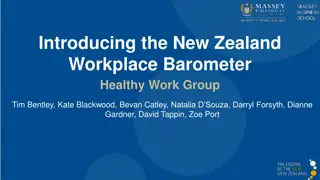Community Child Psychosocial and Mental Health Issues Orientation for PHC Health Workers
This orientation program aims to support PHC health workers in understanding key areas related to child development, identification of disabilities, emotional and behavioral issues, and their role in community child mental health. It also focuses on identifying training needs and areas for capacity building.
Download Presentation

Please find below an Image/Link to download the presentation.
The content on the website is provided AS IS for your information and personal use only. It may not be sold, licensed, or shared on other websites without obtaining consent from the author.If you encounter any issues during the download, it is possible that the publisher has removed the file from their server.
You are allowed to download the files provided on this website for personal or commercial use, subject to the condition that they are used lawfully. All files are the property of their respective owners.
The content on the website is provided AS IS for your information and personal use only. It may not be sold, licensed, or shared on other websites without obtaining consent from the author.
E N D
Presentation Transcript
Understanding Community Child Psychosocial and Mental Health Issues Orientation for PHC Health Workers 22nd& 23rdSeptember 2014 Community-Based Child & Adolescent Mental Health Project Dept. of Child & Adolescent Psychiatry NIMHANS, Bangalore
Introduction & Objectives To introduce our community project and how we will support your work in the next few years. To provide an orientation on some key areas of working with children in the community: Child development Identification of disability Common emotional and behaviour problems Understanding your perception on your role in community child mental health Identifying needs/ areas for training & capacity building.
Key Areas for Child Development Physical Emotional Cognitive Social Language 3
Childrens Developmental Needs: Small Group Work What should they be able to achieve? What do they need to achieve it? Physical Social Cognitive Emotional 0 to 6 years 7 to 12 years 13 to 18 years
Physical Development Abilities/ Skills Needs 0 to 6 years: Gross Motor Skills: mobility, ability to handle objects Fine Motor Skills: pre-writing skills, transfer functions, eye-hand coordination Physical skills necessary self- help: buttoning, brushing, feeding etc. General growth and nutrition Physical activities/ play/ exercise Sensory experiences Fine-motor activities such as beading, colouring, buttoning Ages 7+: Continued physical growth Full independence in self-care. Fine motor tasks easily achieved. General growth and nutrition Physical activities/ play/ exercise Ages 13 to 18: Development of secondary sexual characteristics. Menstruation in girls. Preparation for bodily changes/ education/ awareness.
Social Development Abilities/ Skills Needs 0 to 5 years Recognizing familiar people Understanding rules of play Peer interaction Understanding of spaces (and what happens there) Understanding of sequences and routines Simple rule-based games Naming and pointing familiar people Naming and pointing familiar spaces/ places where child goes + discussion about what is done there Supervised peer interaction, group play, cooperative play (exposure to playgrounds/ play spaces) Use of pictures to explain day s routine/ sequencing 7 to 12 years Development of gender identity Pretend/ imaginative play, group play Same sex/ peer-group play Opportunities for peer group play, forming friendships, Comfort/ security sense of belonging to peer group/ school/ family Affirmative sense of identity 13 to 18 years Development of sexual interests/ orientation. Peer group interactions all important. (need to fit in ). Self-identity/ individuality. Questioning parental/ adult authority. Rules and healthy boundaries, along with opportunities to practice independent decision- making skills. Relationship satisfaction. Clarity on future orientation
Language Development Abilities/ Skills Needs 0 to 6 years: Increase fund of words. Ability to construct short sentences. Express needs. Ability to describe. Naming and pointing games Story telling Phone games Describing games (using pictures or real life observations/events or television clips) Concept book/ flash cards 7 to 12 years: Language used for higher levels of communication to report experiences. Ability to communicate needs and experiences. Opportunities to describe, to be heard, to share experiences. Freedom to communicate needs. 13 to 18 years: Language used for complex social transactions, incl. life skills like refusal skills/ assertive skills/ negotiation. To process complex feelings and relationship dynamics. To articulate opinions and choices.
Cognitive Development Abilities/ Skills Needs 0 to 6 years: Fund of information Knowledge of use of objects Ability to form associations Ability to form categories Sequencing and organizing abilities Ability to understand concepts such as shape, size, distance, directions Puzzles Identification of colors, shapes Story telling (including discussions) Story Completion Use of pictures for sequencing events/ stories Play to demonstrate use of objects Attention enhancing tasks (joining dots, spotting the difference, eye-hand coordination activities) Concept book/ flash cards 7 to 12 years: Learn the difference between right and wrong . Ability to think and reason from concrete visible events. Play more complex rule-based games. Conversations, debating on real life situations and television images, discussions on existing social realities, including inequity. Story-telling, drama. (More complex themes for adolescents: gender, sexuality, abuse, risk behaviours, conflict resolution ) 13 to 18 years: Less likely to accept what is stated by others/ more likely to question. Creative thinking/Abstract abilities can generalize from specific situations. Ability for self-introspection, analysis, judgement.
Emotional Development Abilities/ Skills Needs 0 to 6 years: Attachment and bonding Ability to identify emotions Ability to regulate emotions (responsiveness to soothing/ distress states not prolonged/ separation from attachment figure) Ability to recognize emotional state of another person and ascribe simple reasons to causality Differentiating between positive and negative emotions Providing frequent and timely responses of love/ affection to child, incl. positive feed-back, verbal and non-verbal. Identifying emotions through pictures Story telling Story completion Visual analogue (emotion scale) Listing situations in which a certain emotion is felt ( you are happy when ) 7 to 12 years: Emotional regulation (anger/ anxiety control in context of conflict/ provocation) Ability to report emotional states. Development of empathy. Ability to provide positive emotional response (reassurance/ comfort) Provide disclosive sharing spirit/ opportunity. Opportunities to acknowledge and process intense emotions such as emotions and fear. Appreciation, encouragement Pro-social behaviour opportunities 13 to 18 years: Ability to cope with stress. Developing and making decisions about attraction/ intimate/ sexual relationships. Dealing with peer pressure. Greater need to establish self-identify, independence. Family, school, social support. Life skills negotiation, assertiveness, stress & coping, problem solving Resilient handling of role task, relational & emotional challenges Happy, healthy, responsible sexual behaviour
Children with Disability: Small Group Activity What types of disabilities do you observe in the community? How do you identify them? How do families/ caregivers respond to such children? What do you do when you see such children?
Basic Disability Assessment 1. Compared with other children, did the child have any serious delay in sitting, standing or walking? 2. Compared with other children does the child have difficulty seeing, either in the daytime or at night? 3. Does the child appear to have difficulty hearing? 4 .When you tell the child to do something, does he/she seem to understand what you are saying? 5. Does the child have difficulty in walking or moving his/her arms or does he/she have weakness and/or stiffness in the arms or legs? 6. Does the child sometimes have fits, become rigid, or lose consciousness? 7. Does the child learn to do things like other children his/her age? 8. Does the child speak at all (can he/she make himself/herself understood in words; can he/she say any recognizable words)? 9. Is the child's speech in any way different from normal (not clear enough to be understood by people other than his/her immediate family)? Can he/she name at least one object (for example, an animal, a toy, cup/ spoon)? 10. Compared with other children of his/her age, does the child appear in any way mentally backward, dull or slow? 11
Response to Disability Identification and Referral Family/ caregiver education and support Home-based care (stimulation, developmental activities, skill training) What would your role entail?
Other Vulnerable Children in the Community Children who: Do not go to school/ are responsible for care of family. Have parents who are chronically ill. Belong to families with alcoholism problems. Are from homes where there is marital conflict. Do not/ refuse to go to school.
Children with Emotional/ Behaviour Problems: Small Group Activity Let us take one example of such a child (from each group) and look at: i) Child s home/ family situation ii) developmental impact (5 areas of development) iii)mental health impact
Common Signs & Symptoms of Emotional & Behaviour Problems in Children
Social & Peer Relations Indicators Considerate of other people's feelings Shares readily with other children (treats, toys, pencils etc.) Rather solitary, tends to play alone Helpful if someone is hurt, upset or feeling ill Has at least one good friend Generally liked by other children Kind to younger children Often volunteers to help others (parents, teachers, other children) Gets on better with adults than with other children
Emotional Indicators Often complains of headaches, stomach-aches or sickness Many worries, often seems worried Often unhappy, down-hearted or tearful Nervous or clingy in new situations, easily loses confidence Picked on or bullied by other children Many fears, easily scared
Behavioural Indicators Hyperactivity Restless, overactive, cannot stay still for long Constantly fidgeting or squirming Easily distracted, concentration wanders Thinks things out before acting Sees tasks through to the end, good attention span Conduct Often has temper tantrums or hot tempers Generally obedient, usually does what adults request Often fights with other children or bullies them Often lies or cheats Steals from home, school or elsewhere
Child Abuse Neglect Physical Abuse Sexual Abuse
Identifying Child Neglect Malnutrition (low height-weight)/ abnormally low growth Developmental Delays infants left without stimulation do not babble/ smile/ make eye contact/ cry a lot/ not easily soothed language delays poor social relationships and communication poor motor skills Behaviour problems in Older Children/ Adolescents: voracious over-eating/ indiscriminate eating/stealing food, night wanderings/ sleep problems/ extreme fatigue, enuresis hyperactivity, lack of emotional regulation, inability to delay gratification, impulsive behaviours such as stealing, substance abuse, harmful sexual behaviour (due to unpredictable home environment/ no routine
Identifying Physical Abuse Children at Higher Risk: Younger children Premature babies who are harder to care for Children whom parents see as difficult (to feed/ resists being held) Disabled children Older Children Children with learning/ academic problems & other disabilities Children who are rebellious / do not meet parental expectations of good behaviour
Symptoms of Physical Abuse: Physical Indicators: Bruises Fractures Burns Head and internal injuries Emotional and Behavioural Indicators Shrill/ high-pitched cry (infants/ very young children) Enuresis, anxiety, fearfulness (unpredictability) Withdrawn/ isolated/ verbal inhibition Oppositional behaviour, anger, physically abusive of others (supressed anger) Poor peer relationships (no give-take learnt/ lack of trust/ rejection) Controlling / compulsive behaviours (due to loss of control) Poor self-esteem Truancy/ running away High risk behaviours (substance abuse, sexual experimentation)
Child Sexual Abuse When to suspect sexual abuse: Pregnancy Genital injuries School refusal Decreased scholastic performance Mutism Acting out behaviors Sexualized behaviour Somatization Dissociation Deliberate self harm.
Emergency Responses to Physical & Sexual Abuse Medical Interventions Check and treat for injuries. Consider use of PEP Kit (Post-exposure prophylaxis kit) emergency kit for protection from HIV, sexually transmitted infection and pregnancy. Usually used for rape/ sexual assault survivors Used ideally within 2 24 hours and no later than 48 72 hours). Contains anti-retroviral (HIV), morning after pill (pregnancy) and antibiotics (sexually transmitted infections). Check if medical termination of pregnancy needs to be done for (young/unmarried adolescents) BUT only in consultation with the adolescent!
Persuade parent(s) to seek legal assistance report to police (FIR) or Report to Medical Officer who can report to Child Welfare Committee. Call Childline (Toll Free number: 1098) for assistance and information. Reassure the child and the family.
Health Workers Role What do you see as your role in community child mental health? What ways do you think you could support children with problems? What types of skills/ training would be relevant and interesting to you?
Feedback and Summary What did you learn today? One new thing? A new idea? Something you would like to know more about?
